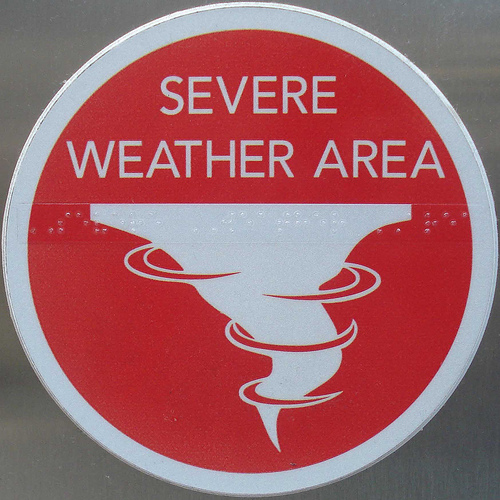Photo: Tom MaglieryCross-posted from Sightline Daily.
Talking about the weather has always been a favorite American pastime. But recent extreme weather events seem to have propelled us into a post-chitchat era. With droughts, heat waves, dust storms, tornadoes, wildfires, and floods dominating the headlines, many folks are starting to talk about the weather with a sense of mystification — if not dread. And some are even beginning to connect the dots between extreme weather and scientific warnings about global warming.
Like many of you, I’ve been trying to sort out what extreme weather means for those of us who communicate regularly about climate and energy policy.
The post-chitchat era poses both opportunities and risks. On the one hand, extreme weather is exactly what scientific climate models have predicted, and we shouldn’t shy away from pointing that out. On the other hand, while there’s data showing that temperatures are rising, it’s impossible to attribute any single weather event to climate change. There’s a risk of overstating the case or being accused of alarmism, opportunism, or exaggeration.
Over the next few weeks, I’ll be looking at how public figures, researchers, scientists, journalists, and regular American voters are talking and thinking about the links between climate and severe weather, with an eye to developing some basic messaging guidelines for climate policy champions.
But first, the lay of the land.
Even with the sun (finally … occasionally) shining in the Northwest, it’s been hard to ignore the unusual flooding, wildfires, and drought that have been pummeling American communities lately — or, for that matter, the weird weather wreaking havoc across the globe. But it took a rash of tornadoes in the American heartland to draw mainstream attention to “weird weather” more generally. What’s emerged is a new kind of conversation about the impacts of climate change. (It should be noted that I made this assertion once before, way back in 2007 — admittedly a bit prematurely.)
Of course, it was tornadoes — with all their gripping, heartbreaking violence and drama, that shocked us to attention. As Pew reported, the “tornadoes that ripped through the Midwest at the end of May dominated the public’s news interest” — by a wide margin — and received much more coverage than any other story that week. And Joe Romm at Think Progress wrote, “the devastation of Joplin, Mo. has led to a super-storm of media stories on the link between climate change and extreme weather, including tornadoes.”
But there’s a bit of a snag; while a warming atmosphere indeed creates the right conditions for more intense storms, when it comes to connecting extreme weather and climate trends, scientists have far more data linking other recent weather phenomena [PDF] to a warming atmosphere. As a result, in the path of the “media storm” Romm describes was a lot of back and forth among climate insiders about tornadoes — particularly around what can and can’t be said conclusively, and dissecting media coverage of the science.
But tornadoes are only part of the story. Heavy rainfall, drought, crop failures, and heat waves also take an enormous toll on human life and property.
One need not get too far into the science to understand the basics. The New Yorker‘s climate specialist, Elizabeth Kolbert, describes it succinctly:
For decades, climate scientists have predicted that, as global temperatures rose, the side effects would include deeper droughts, more intense flooding, and more ferocious storms. The details of these forecasts are immensely complicated, but the underlying science is pretty simple. Warm air can hold more moisture. This means that there is greater evaporation. It also means that there is more water, and hence more energy, available to the system.
And the Center for American Progress makes the important link to human-made, climate-warming pollution:
Atmospheric concentrations of carbon dioxide and other greenhouse gas pollutants are turning up the heat on our planet. Scientists agree that the string of disastrous weather extremes this past year are the types of severe weather that will become more frequent or ferocious as the planet continues to warm.
But many scientists and journalists are still cautious — as are policy folks like me.
But the weather is happening. Thus the conversation is happening. So, the time is now for climate communicators to play a proactive role in parsing the science for laypeople and helping connect the dots — not only between climate and weather but also between weather and policy solutions to curb climate-warming emissions.
Stay tuned for a whole slew of reasons why it’s time to stop erring on the side of caution and to begin addressing the weather-climate connection in earnest in our communications, along with examinations of some possible approaches and frames, at look at public receptiveness to the weather-climate conversation, what messaging experts are saying, and — ultimately — my take on best practices.




